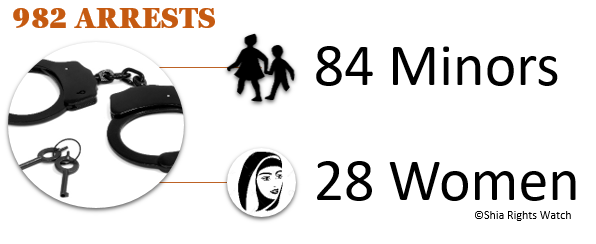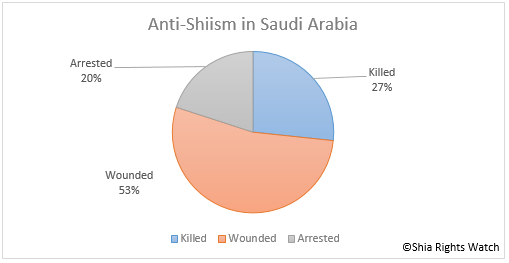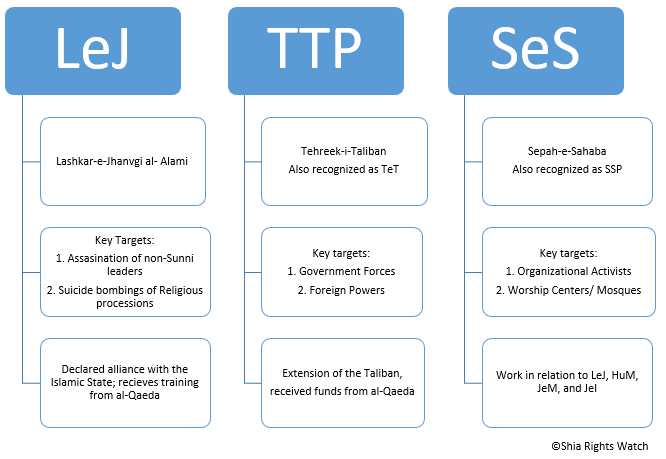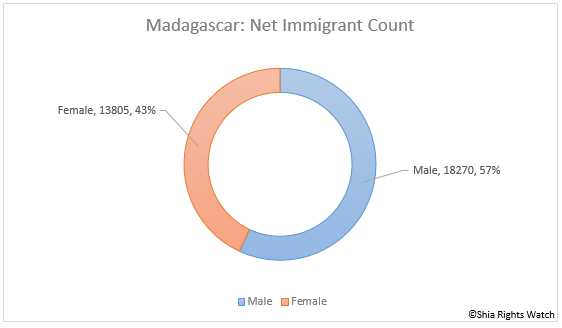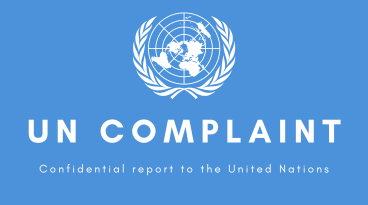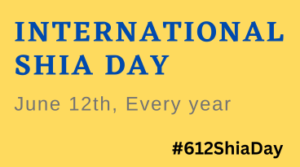Intro
The first half of 2017 has been a turbulent time for Shia Muslims all over the world. Anti-Shiism, or the active targeting of Shia Muslim to limit their visibility and expression, was prevalent in across the globe.
Shia Muslims, including their sub groups, make up approximately 50% of the total Muslim population. Although exact data of Shia demographic remain impossible to collect due to extreme marginalization, a study of current cases of anti-Shiism have been documented by Shia Rights Watch researchers and activist.
This report is a compilation and analysis of trends in anti-Shiism in the six months of January to June 2017. In this report, cases of anti-Shiism in the nations of Bahrain, Saudi Arabia, Syria, Iraq, Iran, Pakistan, and Madagascar are examined. Violations include arrests, vandalism, deaths by unnatural means, and injuries. It is important to note that Shia rights abuses listed in this report are a summary of incidents that have reached SRW. Violations are not limited to those in this report. More information can be found on ShiaRightsWatch.org.
Gulf Nations
Anti-Shiism in Gulf nations has skyrocketed after the Arab Spring of 2011. In fears of an up rise, Gulf countries, specifically Bahrain and Saudi Arabia have increased limitations on their critics. Pro-rights protests in these nations are thwarted with the utmost violence.
Bahrain
The Kingdom of Bahrain has been home to systemic suppression of human rights. Bahrain is a Shia majority nation headed by a non-Shia monarchy. Unlike democratic efforts of other Arab countries in the Middle East, efforts for rights and recognition have remained unnoticed for Bahraini citizens.
The six month period between January and June 30, 2017, a total of 982 people has been arrested. Arrests were with aims to suppress protests. Some were arrested in peaceful protest and others by night time raids. Bahrain has shown little mercy in suppression as 84 of those arrested are minors, and 28 are women.
Approximately 30% of the total arrests, 286, were in a single day in Diraz, Bahrain. On May 23, an armed attack on protesters killed five and wounded dozens. Protestors had arranged a sit in around the home of Sheikh Isa Qassim, who was sentenced to one year in prison and revoked of citizenship earlier that month. After Qassims arrest, the town of Diraz was blockaded, and residents were subject to checkpoints and travel restrictions. Phone and internet lines were cut off for significant hours in the day to limit media contact.
-Protest Met with Violence-
Although protests and demonstrations have been peaceful and demonstrators are unarmed, Bahraini forces meet them with the utmost violence. Bird shot pellets used by forces have led to the death and permanent injury of many protestors and bystanders. Travel restrictions and discrimination have left those injured without medical care as ambulances cannot enter the town and hospitals are ordered not to treat injured protestors. Those arrested report harsh torture and violence in detainment. Ebtissam al-Saegh, a prominent activist has testified sexual assault and coercion of false confessions. Human rights activists striving for democracy in Bahrain report verbal and physical assault as well as threats to thier dignity and even family.
The government’s unwillingness to engage in dialogue has created a rift between it and its citizens. Sources say, Bahraini citizens, do not trust the government. This mistrust, one can relate to the lack of sufficient representation in legislation and years in the suppression of rights by officials. Furthermore, sources report that the extent of Saudi involvement in Bahrain undermines the Bahraini government. Many feel as though dialogue with Bahraini officials are insignificant as officials are under the influence of Saudi policy.
-Future of Bahrain-
With many children and women under arrest, the future of Bahrain is widely destabilized. Children arrested are not able to attend school and in many cases, are not given the opportunity to make up missed work. The current lack of national stability because of direct violence creates an opportunity for foreign involvement in Bahrain. Mistrust and lack of cooperation among protestors and the government have also led to a shift in national identity. SRW predicts a decreased rate in Bahrain’s educated population. Further, due to the increased detainment of women and the high rate of mortality for Shia men, SRW predicts a rise in single parent families and even orphan children. These predictions are further supported by the approximate 780 sentenced Bahraini citizens and the revocation of 92 others. To this point, over 60 people have been given life sentences. The numbers are expected to rise as Bahrain has issued death sentences for many activist despite a de facto moratorium on the death penalty.
Saudi Arabia
Although Shia in Saudi Arabia have practiced their faith in hiding and have lived under marginalization for decades, the last six months note augmentation of violence against this population.
Shia in Saudi Arabia have lived under pressure to conform to the nation’s extremist ideology and forgo their own identity. Since the origin of the kingdom, Shia Muslims have been marginalized; their towns provided the least government funds- lacking in infrastructure and maintenance. Despite their living quarters being home to one of Saudi’s largest oil drills, Shia Muslims are left in the worst of the nation’s conditions of life. Drilling has caused air, and noise pollution and the citizens of the Eastern province are allowed minimal say in policy. While they at least make up over 20% of the population, Shia Muslims lack adequate representation in the government.
-Sources of Anti-Shiism-
Anti-Shiism in Saudi Arabia is fueled by social and religious indoctrination. In numerous cases, Saudi clerics have announced Shia Muslims as outsiders and have deemed them unequal to the nation’s majority Wahhabi population. These beliefs are furthered through educational books and lessons. Information on sources of anti-Shiism can be found on ShiaRightsWatch.org
-Continued Violence-
In the first six months of 2017, the nature of anti-Shiism in this nation shifted. What was once a structural and cultural discrimination becoming direct violence. In mid-May, a siege in the town of Al-Awamiyah became a public attack on this religious sect. The siege began around 3 am. All entrances to the city were closed, and forces shot at buildings and automobiles. Residents were forced from their homes and business were closed.
The government’s claim of aiming to “renew the district” is undermined by social media hashtags and trends used by Saudi forces calling for a “cleansing” of the kingdom from Shia.
The government is threatening the identity of Shia Muslims by demolishing historical sites in Al-Awamiyah. With the demolishment of the al-Baqee cemetery in 1925, Shia in Saudi Arabia lives in fear of not having a presence in their home nation. Further, the decision to “renew” was taken without any representation from the residence, thus adding to their unwillingness to trust the government’s claims.
In attempted to maintain order, forces shot indiscriminately at civilians. The death toll in Saudi Arabia has reached 20. Javad al- Dagher of two years and his family were among those killed. Over 40 people have been wounded in the strife; 15 others have been arrested and face the harsh and unforgiving climate of Saudi prisons. Until now, 14 people have been sentenced to death.
-Regional Instability-
Anti-Shiism in Saudi Arabia has not only incited conflict in the nation; it has led to regional instability. Some state the source of anti-Shiism in Saudi Arabia is fear of Iranian expansion in the region. However, Shia in Saudi Arabia, as well as other nations in the region, have renounced such association. By pressuring their citizens and falsely associating them with a foreign power, Saudi Arabia is increasing insecurity in the Middle East.
Pakistan
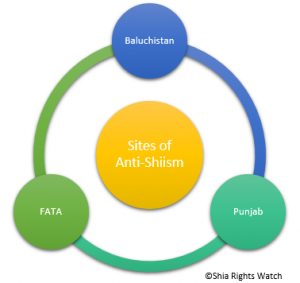 Pakistan stood witness to the death of 193 and wounding 466 others. Incidents of anti-Shiism occurred mainly in the Federally Administered Tribal Area (FATA), Punjab and Baluchistan.
Pakistan stood witness to the death of 193 and wounding 466 others. Incidents of anti-Shiism occurred mainly in the Federally Administered Tribal Area (FATA), Punjab and Baluchistan.
Attacks were carried out by LeJ, TTO, and SeS. Regions of high incidents of anti-Shiism span Pakistan and are mainly cities with a semi-open border with Afghanistan. All attacks occurred in public locations. Both attacks in Parachinar, Kurram Region, occurred in densely populated regions of town.
The targeting of a single population by a number of the nation’s biggest terror organizations points to an existing collective culture of anti-Shiism in which different groups compete to be the most successful. The willingness of these groups to put aside rivalry and work together in orchestrating attacks show the extent of cultural violence against Shia Muslims.
The lack of justice in cases against minority groups in Pakistan are due to existing discrimination within police forces. Many activists have reported a slow cases processing and lack of follow-up on incidents of anti-Shiism.
-Undiscovered Powers-
After the June 24 attacks in Parachinar, governor Iqbal Zafar, on behalf of Prime Minister Nawaz Sharif, distributed Rs 500,000 (appx $5000) to those injured and Rs 1,000,000 (appx $9000) to families of lost loved ones. Compensations came after cross-country protest. Shia Rights Watch estimates, at a minimum, $780,000 was given out by Iqbal Zafar. The Pakistani government aims to compensate death of human life with money, not understanding that conflict cannot be resolved by monetary means. The money handed out to victims of the Parachinar attacks was a means of suppressing protests. The government’s actions display a lack of understanding of the Shia population as Shia in Pakistan are educated and in the position of power as lawyers, doctors and policy makers- money is not a limited resource for many.
Shia Muslims in Pakistan inhabit geopolitically significant areas. Baluchistan, for instance, is rich in natural resource reservoirs and is a key strategic region for Pakistan-Afghanistan diplomacy. Punjab is one of the most economically prosperous regions of Pakistan. Instability in any of those regions creates instability in the area, and thus with the pressures of neighboring countries, the government of Pakistan does the most to reinstate order.
However, counter terrorism effort is misplaced. On June 11, Taimoor Raza was sentenced to death over Facebook content in Okara, Punjab by a “Prevention of Electronic Crimes Act of 2016” which aims to restrict cybercrime offenses. Pakistan’s officials fail to provide effectual security and prevention of hate-crime against Shia communities. Officials are willing to provide monetary compensation to limit social unrest. Shia Rights Watch suggests increased efforts of crime prevention and increased education. Thus, far, post-conflict compensation has been far more expensive that any peace-building effort, and until steps are taken to limit the growth of extremism, in stability in Pakistan will continue.
Syria
Shia in Syria populate the cities of Deir al-Zour, Haoula, Khan al-Asad, Idlib, Nubul, al-Zahra, Hama, al-Foua, Keferya, Homs, and Zarzur. To this point, the conflict in Syria has led to the death of over 400,000 people, a significant portion of which are Shia Muslims in addition to political conflict, Shia in Syria suffers from targeted killing by active terror groups such that of ISIS.
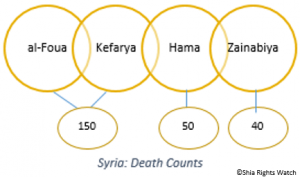 Discreet numbers of anti-Shia incidents are limited due to the turbulent status of the nation. However, despite limitations, SRW estimates continued targeting of Shia Muslims as per ground sources as well as the statistical prevalence of attacks on Shia towns and cities.
Discreet numbers of anti-Shia incidents are limited due to the turbulent status of the nation. However, despite limitations, SRW estimates continued targeting of Shia Muslims as per ground sources as well as the statistical prevalence of attacks on Shia towns and cities.
The largest reported incident of anti-Shiism was in the village of al-Foua, and Kefarya in which a suicide bomber targeted a bus carrying children evacuated from the town- 150, 72 of which were children, were found dead because of the explosion.
Sources in Syria report an attack on the city of Hama as the next largest reported attack in Syria. Of the 50 killed, 24 were women and children. Medical personnel in nearby hospital report death by blunt force trauma by rocks and stones. Despite immense efforts, retrieval of bodies was not possible as many of the bodies were dismembered beyond recognition. The extent of damage to the deceased points to an ideology that views Shia as non-human.
Among incidents of anti-Shiism are double bombs killing 40 Iraqi pilgrims visiting the Zainabiya Shrine and wounding 120 others.
ISIS and their affiliates are fueled by anti-Shia sentiment taught by the Wahabi school of thought. The coordinated attacks which target pilgrims and evacuees point to an anti-Shia agenda consistent with the Wahhabi ideology.
Iraq
Iraq remains one of the most turbulent locations for Shia Muslims. ISIS infiltration and lack of government security create an opportunity for anti-Shiism. In the first six months of 2017, 260 people have lost their lives, and approximately 250 people have been injured as a result of anti-Shia sentiment.
Consistent with a five-year trend, Shia neighborhoods of Baghdad remain one of the most targeted areas. As early as January, suicide bombings claimed the life of 20 and injured more than 60 people in a marketplace in the district of Jamila. A week later, a car bombing killed 48 and left tens of others injured.
Karbala was also home to Shia Muslims killed in the past six months. In the Musayyib district, east of Karbala, a woman detonated her vest killing 34. On the same day, a bomb at the entrance of the city killed 4, and a failed explosive was cleared from the holy Shrine located in Karbala.
Same day bombings are signs of existing extremist networks that remain prosperous despite anti-ISIS efforts.
Iraq is home to many important Shia shrines and historical sights. These locations ensure a constant influx of Shia Muslims to the nation. Thus, Shia Rights Watch calls for a plan of security that is unique to this nations traveler entry.
Iran
In the first half of 2017, the world stood witness to an explicit expansion of ISIS forces. Early June, ISIS forces detonated explosives in two key political locations in Iran: the parliament and the Khomeini Mausoleum. The setting of the incident was highly symbolic to the Revolution of 1979.
Terrorists entered the administrative building as constituents, some women, and detonated explosive vests killing 12 and wounding 40 others. ISIS later released video accounting for their time within the parliament building inducing fear of increased ISIS activity in the nation.
In addition to increased tensions in the region, this incident was a show of anti-Shiism as ISIS forces targeted one of the most Shia populated countries in the Middle East. Attacks in Iran point to a definite shift an anti-Shiism.
Madagascar
Due to the islands vast resources, Madagascar has been home to increased Muslim immigration. Mid-May, Yanish Ismail, son of a prominent Shia businessman was kidnapped by 14 armed assailants as he was attending a funeral.
Ismail’s case is the second incident of anti-Shiism in the past five years. SRW fears a wave of anti-Shiism in this nation. Roots of hate crimes, SRW predicts, spreads from existing anti-Shiism in other countries.
Afghanistan
From January to June 30, 17 lives were lost, and 23 were injured as a result of anti-Shiism. Of total incidents, 65% of attacks occurred in the month of June. Early June, a motorbike bomb detonated outside Jama Mosque of Herat, killing 7 and wounding 16. Later that month, a terrorist targeted a Shia mosque outside of Kabul. After exchanging fire with police, he entered the mosque kitchen and detonated his explosive vest. The incident led to the death of four and left seven others injured.
The Hazara ethnic group are frequently targeted as they are identified in features and widely recognized as Shia Muslims. Structural anti-Shiism in Afghanistan has led to a lack of protection and prosecution of this ethnic community.
Mass exposure was guaranteed in both attacks as terrorists targeted Shia mosques, and that in the month of Ramadhan. Muslims regard Ramadhan as a holy month. However, anti-Shia organizations such that of ISIS and the Taliban do not consider Shia as Muslims. Previous to Ramadhan, in a speech, ISIS leaders renounced Shia, called for their cleansing and promoted the month of Ramadhan as the best month for anti-Shia action.
Global Trends of Anti-Shiism
A macro-scale analysis of cases of violence against Shia Muslims shows significant trends. Such patterns can be used to analyze Anti-Shiism and plan peace building endeavors.
Analysis of anti-Shia cases points to widespread cultural violence because of miseducation. For decades, the Wahhabi school of thought has promoted education dehumanizing Shia Muslims. Some historians have identified the political and economic basis of such education. More information on historical cases of anti-Shiism can be found on ShiaRightsWatch.org. Anti-Shia education can be found in the Middle East and North Africa, and such education has become a cultural feature. A culture that undermines Shia Muslims as human-beings with fundamental rights has allowed hate-crime by a violent group to prosper. In addition to ideological targeting, anti-Shiism occurs because of misrepresentation of Shia Muslims. For instance, sources report anti-Shiism in immigrant populations who see Shia Muslims as the source of insecurity in their jobs. Their lack of awareness of who the Shia are lead them to criminalize Shia and the Shia struggle for recognition.
In some cases, explosions are coordinated by time, date and location. Synchronization, analyst claim, tells tales of existing networks and communications among different terror organizations with a shared ideology. The fact that most the attacks were suicide bombers point to the extent at which attackers hold the anti-Shia ideology.
The setting of attacks is in confirmation that attacks reported in this report were not random, but targeted towards mass Shia populations. Attacks are aimed at limiting Shia visibility and expression.
Anticipating the Next Six Months
Prosecution of agents of Anti-Shiism is practically non-existent in the aforementioned nations. In states in which the national government leads anti-Shia efforts, justice seems far-fetched for many. In Pakistan and Iraq, anti-terrorism efforts do not meet minority efforts thus endangering Shia constituents.
Shia Rights Watch anticipates a spread of anti-Shiism to other regions of the world. In both Europe and South Asia, incidents have been seen. Although these events were isolated, they did cause infrastructure damage, physical and psychological damage to Shia Muslims in those areas. Details on incidents in South Asia and Europe can be found on ShiaRightsWatch.org.
Incidents of anti-Shiism will continue to rise in the next six months unless efforts to decrease hate crimes are taken. Incidents of anti-Shiism tend to grow in holy months, especially in Moharram, a month many recognize as the corner-stone of the Shia identity. Moharram begins in September 2017, and with it, Shia processions will be in danger of violence unless measures to protect this population takes place.
-Suggestions-
- Dialogue between governments and constituents
- Both activists and government officials must realize dialogue and cooperation are the only means of building understanding and coexistence in their nations. Common aims must be identified and used as the basis for building a prosperous nation.
- Increased activism of Shia Muslims in their communities
- As the most powerful force against anti-Shiism, Shia Muslims must empower their communities for self-expression. Shia Muslims must build a presence in their nations by being ideal citizens in their countries in the international communities.
- Education on human rights for all minority populations
- Minority communities must be aware of their rights as given by the United Nations Declaration of Human Rights and their nation’s constitution. Minority populations must be able to recognize discrepancies in their rights and take peaceful steps in raising awareness.
- Raising accurate media coverage
- The media is a major medium for raising awareness and education. Shia Rights Watch calls upon media outlets to check accuracy and provide un-biased coverage of Shia Muslims.
- Shia Rights Watch further encourages active Shia communication with local and international news sources. Shia communities are the best first line defense against anti-Shiism, thus they must work with media outlets to raise awareness in regards to their communities and remove misconceptions.



